David Suzuki's Blog, page 6
June 28, 2017
People just like you are fighting for environmental justice
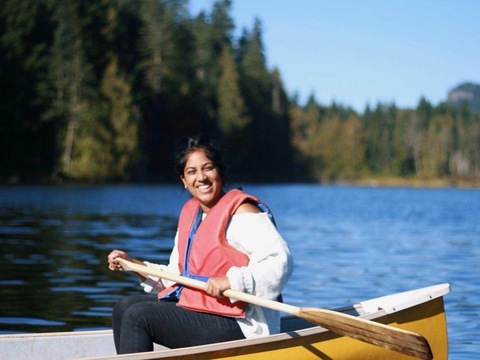
Maya Menezes paddling through lake country.
"In a world of more than seven billion people, each of us is a drop in the bucket. But with enough drops, we can fill any bucket." ~ David Suzuki
Across the nation, innovative people from every walk of life are promoting biodiversity, climate solutions and the right to a healthy environment where they live. Each month, Queen of Green will feature someone using their unique gifts to build a greener future for everyone.
Meet Maya Menezes, daughter of immigrants from India and Pakistan. Maya grew up in Toronto, the territory of the Dish With One Spoon agreement. She specialized in food sovereignty, social justice equity and environmental studies at the University of Toronto. She's director of development for the Toronto Environmental Alliance, works with migrant justice organization No One Is Illegal -Toronto and serves on the boards of Toronto350 and Web of Change.
What inspired you to work on environmental issues?
Growing up in the concrete jungle of Toronto, I never understood nature's importance or connection to the land. My family travelled extensively in our little minivan. I hugged ancient redwoods in Big Sur, sat on cliff sides in Halifax and hiked the Bruce Trail. But I didn't "get it" until I moved to British Columbia. I discovered the wild and my place in it on Coast Salish territories.
Yet Vancouver Island misses things crucial for me: people of colour, diversity, a thousand languages spoken on every street corner. I realized that the country on our postcards is a privilege for those who can afford it, that travel is a class privilege that comes at great expense of those in need.
I wanted to work in international development, until I came to understand it as neo-colonialism. I couldn't reconcile my want for adventure with that oppressive, marginalizing framework. So I moved back to Toronto to far less glamorous, but far more decolonizing work.
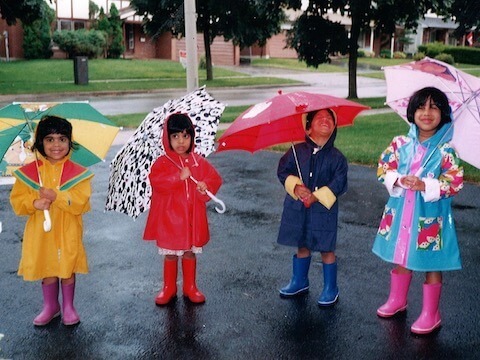
What keeps you committed to promoting environmental sustainability?
I'm inspired by the connections between worker disenfranchisement, institutionalized racism and climate disaster. I'm proud to ally with the End Immigration Detention Network and No One Is Illegal, who are challenging the constitutionality of indefinite detention in Ontario. The incarceration of black and brown bodies is directly tied to climate change, mass migration and the global refugee crisis. My TEA colleagues are fighting for Toronto to adopt a climate strategy that will dramatically reduce GHG emissions and work towards poverty reduction, energy retrofits and safe subsidized housing. This is climate justice in action. It gives me hope for the future. Toronto organizations are fighting for the same outcomes in different ways. Reaching out across imaginary borders to build lasting solidarity is the only path I see forward.
What did you learn from attending COP22 in Marrakech?
There, I saw a group of heavily tokenized Indigenous and brown folks tossed haphazardly into a white system that was more carefully staged photo ops and grandiose symbolic gestures than real action or change. The most mind-blowing thing wasn't COP itself, but the marginalized folks. I saw the most beautiful resistance on the fringes. Hundreds of Indigenous peoples from across the world came together to share strategy and solidarity with Standing Rock. Fellow South Asians and femmes from around the world shared tactics, successes and failures, so that we can all learn how to build power. It reminded me that real change always happens on the ground, with communities on the front lines, and that honouring resistance and supporting it from behind are the foundational building blocks on the life-long road of being an ally.
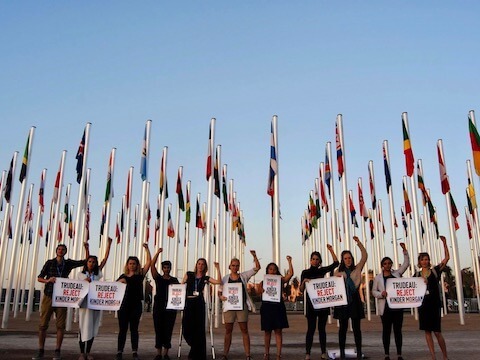
How can the environmental movement be more accessible, relevant and inclusive to folks from diverse cultural and socioeconomic backgrounds?
Signing petitions against the tarsands without Indigenous solidarity, pipeline blockading and honouring the treaties is not resistance. Buying organic without understanding the plight of racialized migrant workers is not justice.
The environmental movement is Indigenous, black, brown, poor and has been happening for thousands of years. The best thing I can do is join front line communities in their struggle for dignity and rights. This means leading from behind and doing what is asked of me -- amplifying voices, doing the behind-the-scenes grunt work of movement planning and fundraising, or using my privilege to help more marginalized folks navigate legal, housing and policy pathways.
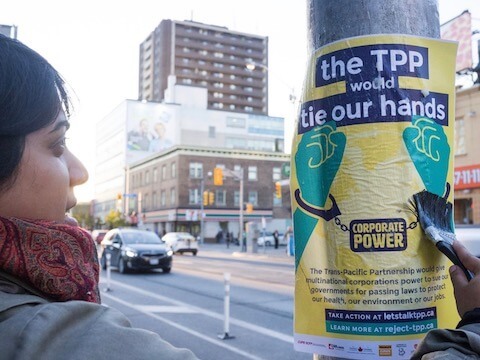
What's the "Brown Caucus" and why is it important?
The Brown Caucus is a group of folks who've worked in climate organizations and youth-mobilizing forces most of our lives. We were saddened by how difficult it is for youth in the South Asian diaspora to enter climate spaces. Some of it has to do with "model immigrant" socialization -- the trauma of families leaving war and poverty, hoping for the best for their kids. The pressure to enter a high-paying corporate job is crippling. It usually distances youth from decolonization and justice work. We wanted to open a space where young, brown folks could come together and learn how to enter the environmental movement in a safe way, and vent about micro-aggressions and institutionalized racism -- including racism we face in our daily jobs. We address what it means to be racialized settlers on these territories, the rampant anti-black racism in South Asian communities, and how to manage the road ahead.
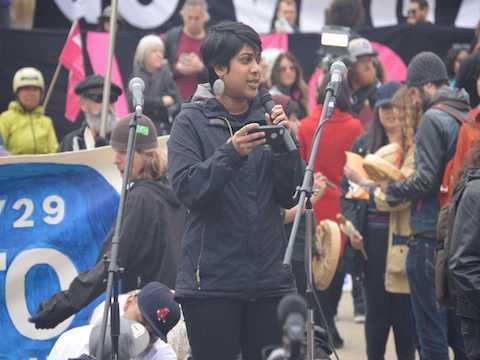
What advice do you have for creating sustainability initiatives in urban communities?
Learn on whose back your community exists -- whether that's your food system, energy production or your place in urban gentrification. Work every day for their liberation. Your liberation is directly tied to theirs. Fearlessly fail forward.
Do you know someone who deserves recognition for doing exceptional work protecting nature? Nominate a green leader from your community by commenting on this blog or through the Queen of Green facebook.
Sincerely,
Nikki Sanchez, a fellow Queen of Green
Hey! Want more DSF? Join David Suzuki on Facebook

Grassy Narrows mercury cleanup plan is long overdue; David Suzuki visits community
TORONTO (June 28) -- The Ontario government's plan to clean the mercury-contaminated Wabigoon River system is welcome news, says the David Suzuki Foundation. The Ontario government announced it will spend $85 million to clean the mercury that has poisoned the people of Grassy Narrows First Nation and nearby Whitedog First Nation for generations. The English-Wabigoon watershed cleanup is expected to begin next year.
Renowned scientist and broadcaster David Suzuki is visiting Grassy Narrows First Nation today on the heels of the government's announcement. The community invited him to hear how mercury contamination has devastated the community and the local environment. Grassy Narrows and neighbouring Wabaseemoong (Whitedog) First Nations are downstream from one of the worst toxic sites in Canada, the former Reed Paper mill in Dryden, Ontario.
In the 1960s, the company dumped more than 9,000 kilograms of untreated mercury waste into the Wabigoon River. Though the mill (under new ownership) has long since stopped using mercury, evidence indicates the toxic chemical is still leaching into the river from the former industrial site, poisoning fish, which the communities depend upon. Ninety per cent of people tested in Grassy Narrows and Wabaseemoong show evidence of acute mercury poisoning, including numbness in fingertips and lips, loss of coordination, trembling and other neuromuscular conditions.
The David Suzuki Foundation has been working with Grassy Narrows in support of the cleanup.
"The hopeful resolution to Grassy Narrows' nightmare is thanks to the people of Grassy Narrows. Elders, hunters and trappers, fishers, mothers and youth have campaigned tirelessly for decades to get environmental toxins cleaned from the river, so they can once again eat its fish and practise their culture without fear of getting sick," said David Suzuki Foundation Ontario and Northern Canada director general Faisal Moola.
"I met with Premier Kathleen Wynne earlier this year and was encouraged by her personal commitment to right a historic wrong at Grassy Narrows," David Suzuki said. "The people of Grassy Narrows have fought for more than 40 years to hear an Ontario premier commit to clean their river. The government needs to promptly implement a remediation plan with strict timelines, developed by Grassy Narrows and its science advisers."
The river cleanup, led by Grassy Narrows First Nation, is the first step. Grassy Narrows continues to call for a home for survivors in the community, a fair mercury compensation system, top quality health care and a permanent environmental health monitoring station.
- 30 -
For more information or to arrange an interview, please contact:
Brendan Glauser, David Suzuki Foundation, 604 356-8829, bglauser@davidsuzuki.org
Hey! Want more DSF? Join David Suzuki on Facebook

Citizen-led "Butterflyway" blooms in Toronto's east end
David Suzuki Foundation volunteers celebrate new corridor for bees and butterflies
TORONTO, June 28, 2017 -- Over the past two months, David Suzuki Foundation volunteers have planted a network of seventeen new butterfly-friendly gardens in Toronto's east end, including schoolyard butterfly gardens and wildflower-filled canoes in parks. The plantings were established as part of the Butterflyway Project, a national effort to reimagine neighbourhoods as highways of habitat for local pollinating critters, from bumblebees to monarch butterflies.
"We're excited to announce that our team of Butterflyway Rangers has created Canada's first Butterflyway in the Beaches and Leslieville neighbourhoods," said Butterflyway Project manager Jode Roberts. "With help from city parks staff, local councillors, businesses, parks groups, teachers, Girl Guides and gardening groups, the east end Rangers have made remarkable progress, creating a Butterflyway through their neighbourhood!"
The David Suzuki Foundation began recruiting residents in Victoria, Richmond, Toronto, Markham and Montreal in March to be part of the program. More than 150 keen volunteers were selected and trained as "Butterflyway Rangers" who are being supported in their collective mission to create patches of butterfly- and bee-friendly habitat in their neighbourhoods. Neighbourhoods where Ranger troops plant a dozen or more pollinator patches will get official David Suzuki Foundation Butterflyway designation, including signs and inclusion in the national Butterflyway Project map.
Ranger-led activities have ranged from creating butterfly-themed costumes and a bike-trailer garden that won second prize in a local parade in Victoria to the planting of a dozen old, retired canoes filled with wildflowers in Markham and Toronto. In Toronto's west end, a pair of Rangers led the Butterflyway Lane art project, painting butterfly-themed murals on two dozen garage doors, walls and fences in a laneway facing Garrison Creek Park.
The Toronto Butterflyway Rangers were recruited from the Beaches and Leslieville neighbourhoods in the east end and from Cedarvale-Humewood neighbourhood in the west end. The east end locations where pollinator patches have been created to date include:
Adam Beck Junior Public School
Beach Hill Street Tree Pollinator Patches
Beaches Library Pollinator Patch
Beaches Recreation Centre Pollinator Patch
Bruce PS / Woodgreen ELC Pollinator Patch
Enderby Child Care / Woodgreen ELC Patch
Girl Guide Pollinator Patch at 1939 Queen
Ivan Forrest Gardens Canoe Garden
Kew Park Montessori School Pollinator Patch
Leslieville Jr PS Pollinator Patch
Leuty Beach Boathouse Pollinator Patch
Main Street Library Pollinator Patch
Morse Street Jr PS Pollinator Patch
Norway Jr PS Pollinator Patch
Phin Ave Parkette Canoe Garden
The Balmy Beach Club Pollinator Patch
Williamson Road Jr PS Pollinator Patch
The Butterflyway Project is based on the David Suzuki Foundation's award-winning Homegrown National Park Project (www.davidsuzuki.org/homegrown) and is generously supported by Nature's Way and Cascades.
For further information, please contact:
Jode Roberts, David Suzuki Foundation, 647-456-9752, jroberts@davidsuzuki.org @joderoberts
Hey! Want more DSF? Join David Suzuki on Facebook

June 26, 2017
The Milkweed Adoption Program - Thank you!
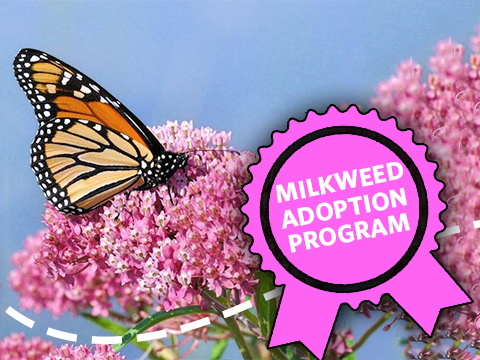
Thanks for joining the Milkweed Adoption Project! You're on your way to becoming a citizen scientist (while also helping monarch butterflies).
Here's what you can expect in the next year:
An email in spring 2018 asking you to report back on when the plants flower
An email in late summer 2018 asking you to report back on when the plants seed
Monarch butterflies!
We look forward to seeing you soon.
Please bring a bag or box to carry your two milkweed plants in.
PS - Know anyone else that should be a milkweed parent? Send them the form as soon as possible -- we only have spots for 200 households.
Hey! Want more DSF? Join David Suzuki on Facebook

The Milkweed Adoption Program

Want to become a citizen scientists AND help monarch butterflies? Join the Milkweed Adoption Project.
The David Suzuki Foundation and University of Toronto-Scarborough are excited to team up to learn more about milkweed in the city -- and we need your help!
As part of the Butterflyway Project, DSF will be providing two milkweed plants for up to 200 households in Toronto.
Participants will plant the milkweed in their gardens this summer and commit to reporting when the plants being to flower and go to seed next year.
UTSC will use this citizen-reported data to better understand how the built environment affects pollinator-friendly plants.
Milkweed supports a wide range of pollinators, like wild bees and hummingbirds, and is the plant that monarch butterflies depend on for survival.
The plants are free and will be available for pickup up on July 5 from 3-7 pm at the Fairmont Market in Greenwood Park or in Christie Pits Park from 5-8 pm on July 6.
To reserve your milkweed plants, you must fill out the form at this link prior to pickup. Supplies are limited, so please sign up ASAP.
Online Form - Butterflyway Milkweed Adoption ProgramOnline Form Builder
What are we studying?
In cities, variability in temperature due to the structure of the built environment leads to changes in flowering time and seed set of different plants we use in gardening and pollinator habitat.
In this study we are interested in working with citizen scientists to track the phenology of swamp milkweed (Asclepius incarnata) across the city of Toronto and its contribution to pollinator habitat.
Hey! Want more DSF? Join David Suzuki on Facebook

June 22, 2017
Bicycling never gets old!
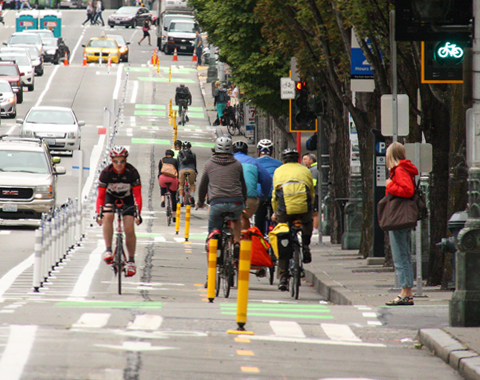
(Credit: SDOT Photos via Flickr)
Two hundred years ago this month, an environmental and fuel crisis inspired one of our greatest inventions -- a device so simple, efficient and useful that it's turning out to be part of the solution to today's environmental and fuel crises.
As a Treehugger article explains, the eruption of Indonesia's Mount Tambora in April 1815 spewed so much ash and sulphur dioxide into the atmosphere that it blackened skies, and 1816 became known as the year without summer in much of Europe and North America. The largest volcanic eruption in recorded history led to widespread crop failure and famine. Livestock died because there was little to feed them, and they became food themselves. The costs of fuel for horses, mostly oats, soared.
German forester Baron Karl von Drais needed a way to inspect tree stands without relying on horses. In June 1817, he built a simple wooden two-wheeler, without pedals, that he called the Laufsmaschine, or "running machine" -- although it came to be known as a draisine. His invention led to the first conflicts between cyclists and users of other transportation modes, including pedestrians. Carriage ruts in unpaved roads made manoeuvring on two wheels difficult, and cyclists started riding the brakeless bikes on sidewalks, which led to widespread complaints and bans in some countries, including Germany. Many people were simply opposed to the newfangled devices and their riders.
These conflicts diminished popularity of the early two-wheeler. The later pedal-powered penny farthing, with its huge direct-drive front wheel and small back wheel, suffered a similar backlash. But technological advances -- such as rear chain drives, ball bearings, pneumatic tires and freewheels -- eventually made bicycles a more viable transportation mode. Today, technologies like lighter frames and better gearing, as well as electric bikes and share programs, are making cycling accessible to more people.
Bikes and their riders still face backlashes -- in part because so much urban infrastructure has been dedicated to motorized vehicles and, to some extent, pedestrians, leaving cyclists to compete for space. As civic leaders and citizens gain a better understanding of the benefits of getting people out of private automobiles -- reduced pollution and climate-altering emissions, less gridlock and more human-centred urban design among them -- municipal governments and supporters are working to create more, safer spaces for cyclists. Many cities, including my hometown of Vancouver, are expanding separated bike lane networks, and some employers and businesses are providing encouragement through better parking and showers for cyclists.
The benefits of increased cycling go beyond reducing pollution and greenhouse gas emissions. Riding a bike is good for your physical and mental health. Bicycles can move more people with less space and are far more efficient than cars. Most of the fuel used to power a car is either lost or used to propel the massive vehicle, whereas fuelling a bike's engine -- that's you -- requires only a healthy diet. In cities where traffic is heavy, cycling is often faster than driving. It's even more energy-efficient than walking! You can also save a lot of money on fuel, parking, maintenance, insurance and purchase.
Costs to society -- and taxpayers -- are also lower. Bikes are easier than cars on infrastructure such as roads, help reduce health care costs and can alleviate poverty as people spend less on vehicle-related costs. Streets become more human-centred, and businesses along bike lanes can benefit.
Cycling isn't possible for all people at all times, especially during harsh winters. But as more people get out of their cars, those who need motorized transportation -- whether private automobiles, taxis, emergency vehicles or transit -- will experience less gridlock and competition for parking, along with greater safety.
Those who fear risking injury or even death from cycling have valid concerns. Collisions with larger vehicles or even other cyclists, breathing pollution from cars and getting caught in inclement weather are all possible. But many of those risks are reduced with better cycling infrastructure, such as separated lanes, and proper clothing, lights and repair kits. Studies have also shown the health benefits of cycling outweigh the risks.
Two centuries after their invention, bicycles are still the most efficient and beneficial form of transportation we have. Get out and ride if you can! It's good for you and the planet.
Hey! Want more DSF? Join David Suzuki on Facebook

June 20, 2017
How to de-clutter
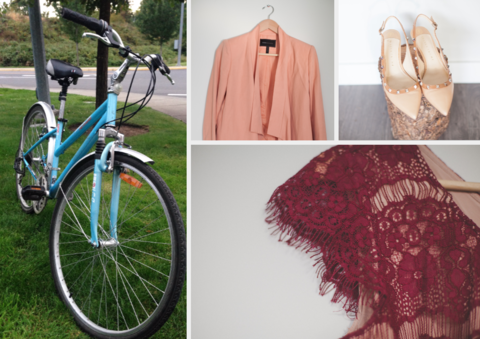
Declutter your life and home with eight simple tips from Queen of Green assistant Breanna Carey.
If you aren't using your things, get them into the hands of people who will! The goal: Only hang on to items that serve you now.
Here are eight starting points:
Bedroom Starting in a corner, clear off one surface at a time. Donate what you don't want to organizations such as WIN or sell via VarageSale or FaceBook.
Home office Clear everything off your desk except your computer. Choose three items you must have within arm's reach. Sort the rest into three piles: review, donate, toss. Take old computers to a second-hand shop.
Kitchen Look for "forgotten" things tucked away in hard-to-reach places.
Garage, carport or storage locker See if your neighbours are interested in your unused bikes and sports equipment. Or snap photos and post for sale online.
Camping, BBQ equipment Offer for free online. (Clean goods go faster than dirty ones.)
Anything with wheels Post vehicles on autoTrader and engine-less wheels on Used(your city), VarageSale, Craigslist and Kijiji.
Closet Local shoemakers may be able to use parts of shoes in reasonable shape. The rest: Consign, sell online through second-hand marketplaces or donate to local charity thrift stores.
Pet goods Rescue organizations need animal transport crates, old towels, leashes and dishes.
For more recycling ideas, check out this page.
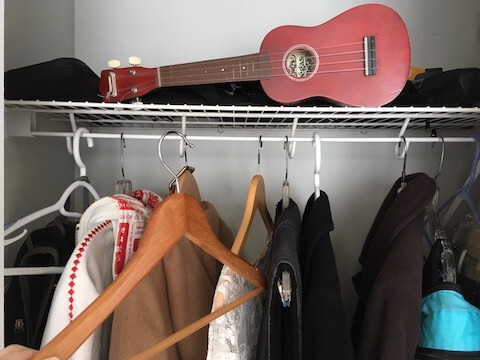
The sharing economy helps build community and keep useful items out of the landfill.
Great, close-up photos are key to successful online transactions. Create a descriptive, enticing post. Be sure the stuff you're selling is in season.
Toronto's Sharing Depot and the Vancouver Tool Library let people borrow items for a nominal annual membership fee. Many meetup groups host "Fix it" or Repair Cafés -- consider organizing one for your neighbourhood. A block garage sale/BBQ is a way to both socialize and reduce waste.
Ultimately, bring less into your home. In her book A Bunch of Pretty Things I Did Not Buy, Sarah Lazarovic's "Buyerarchy of Needs" puts "use what you have" at the top, followed by borrow, swap, thrift, make and finally buy. Switch your thinking from "I want that. Where can I buy it?" to "Do I really need that?" and "Can I find it another way?"
Clearing space in our homes -- and minds -- feels great! Here's some reading material to help:
Goodbye,Things by Fumio Sasaki
The Curated Closet by Anuschka Rees
The life-changing magic of tidying up by Marie Kondo
Clutterfree with Kids by Joshua Becker
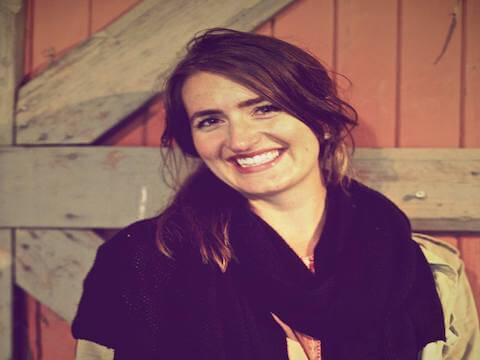
What are your de-cluttering tips?
Breanna Carey, Queen of Green volunteer assistant and fellow Queen of Green
Hey! Want more DSF? Join David Suzuki on Facebook

David Suzuki Foundation awards three $50,000 climate change fellowships
David Suzuki will mentor fellows to help lead the next generation of science communicators
VANCOUVER (June 20, 2017) -- The David Suzuki Foundation has awarded $50,000 one-year David Suzuki Fellowships to three leading Canadian scholars, who will spend 2017-18 studying climate change solutions.
The winners are:
- Melina Laboucan-Massimo, MA in Indigenous governance -- Indigenous Knowledge and Climate Change Fellow
- Brett Dolter, PhD in ecological economics -- Climate Change Economics Fellow
- Jérôme Laviolette, MA in applied science -- Transportation and Climate Change Fellow
"Climate change is the most serious and urgent issue we face," David Suzuki said. "To help chart our path and tackle the impending climate crisis, we must develop the next generation of scientists who not only excel at science in laboratories and in the field, but who can also tell stories and communicate effectively to engage masses of people in the global shift toward a clean energy economy. With the U.S. recently withdrawing from the Paris Agreement, it's more important than ever to build knowledge and understanding of solutions."
Laboucan-Massimo has campaigned internationally with Greenpeace Canada, and has produced films about Indigenous peoples and environmental issues. She will research renewable energy models that can be replicated in communities in Canada, helping to create green jobs and reduce our reliance on fossil fuels.
"My life path has taken me far from my community, to fight for my people and the sacredness of Mother Earth on an international stage," Laboucan-Massimo said. "The lessons and skills these travels have brought me are ultimately gifts that I have always intended to bring back to communities affected by climate change and fossil fuel extraction. Indigenous communities are on the front lines of resource extraction and climate change, but we are also on the front lines of solutions."
Dolter recently co-created a programming model to explore the costs of decarbonizing Canada's energy systems, and is co-writing a book with York University economist Peter Victor.
"The environmental movement can do a better job of reaching out to people with conflicting beliefs," Dolter said. "Well-facilitated deliberative dialogues can help citizens build shared understanding, and this can help transform environmental politics and our democracy."
Laviolette's MA research uses GPS data to better understand the demand-supply profile of the taxi industry. For the fellowship, he will focus on better understanding individual car dependency and the barriers and opportunities to change this behaviour.
"I became an engineer because I want to use science to find sustainable solutions to today's major issues," Laviolette said. "I intend to find creative ways of promoting sustainable transportation options, initiating positive and long-term change in people's mobility behaviour."
The David Suzuki Fellowships program will help the next generation of environmental leaders tackle complex problems and inspire change. Fellows will be mentored to perpetuate David Suzuki's model of communicating science in ways that are easy to understand and act on.
The 2017-18 winners will be celebrated at a reception in Vancouver in September, when the 2018-19 David Suzuki Fellowships program details will also be announced.
- 30 -
For more information or to arrange an interview, please contact:
Brendan Glauser
David Suzuki Foundation
bglauser@davidsuzuki.org
604-356-8829
Note to editors:
Photos of the three 2017-18 fellows and a fellowships fact sheet are available by contacting the David Suzuki Foundation.
Hey! Want more DSF? Join David Suzuki on Facebook

June 19, 2017
SolarShare's Kingston project combines biodiversity with technology
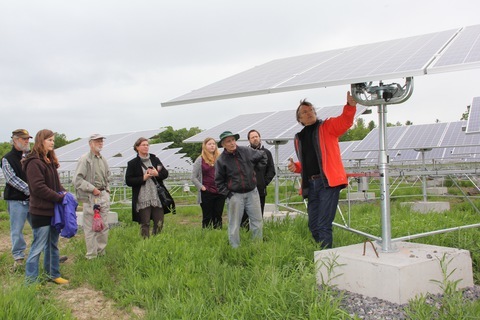
Credit: SolarShare
"It's not a great place to grow food," president of SolarShare renewable energy co-op Mike Brigham says, pointing to a rock-strewn farmer's field at the edge of Kingston, Ontario. "But it's certainly a good place to generate electricity."
Brigham is leading a tour at the launch of the co-op's $2.4 million Abbey Dawn project. It's a 500-kilowatt array of dozens of ground-mount solar panels deploying a new, Canadian-made system that optimizes power production by tracking the sun as it moves across the sky.
Technically in the city, the Abbey Dawn site feels rural and rustic. Perched on the edge of a bird sanctuary -- you're more likely to see turkey vultures than people here -- the project has ecological integrity at its core.
Brigham says photovoltaic systems produce peak power when Ontario needs it most (summer afternoons when air conditioning is at maximum) so the project reduces reliance on natural gas "peaker" plants that contribute to climate change.
The solar modules are warranted for 25 years but Brigham believes they'll produce clean power for the better part of half a century. And they won't create much waste at the end of their useful life, according to engineer and member of the Ottawa Renewable Energy Co-op Nate Preston: "When it comes time for decommissioning, the aluminum frames and silicon-based panels can be recycled."
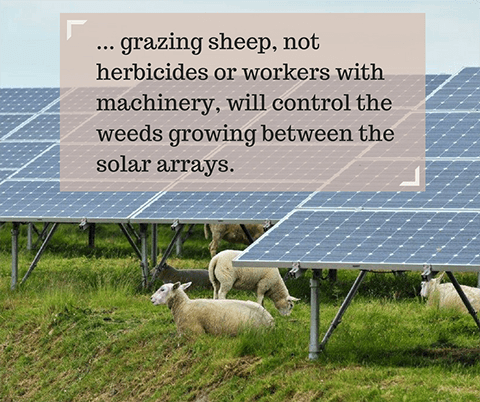
Clean-up costs will be minimal. There are no underground foundations to remove, no toxic leakage. And if farmers 50 years from now want to return the field to agriculture, they'll find the soil uncontaminated.
Abbey Dawn has virtues beyond being a solar project. Brigham hopes grazing sheep, not herbicides or workers with machinery, will control the weeds growing between the solar arrays. (He stresses the groundskeepers mustn't be goats: "They'd eat everything, including the electrical wiring!")
He's also hoping to bring beehives and clover to the site, and other pollinator-friendly plants to attract butterflies. The developers are creating a kind of Promised Land in Southern Ontario: a land flowing with milkweed and honey will surround the emissions-free energy panels.
Driving back to downtown Kingston, Preston and I chat about solar energy's future. "The technology's very scalable," he says. This is helpful because our upcoming power needs, even a few years hence, are not yet clear. We may need more juice or, if conservation programs are successful, less. While nuclear, for example, locks us into massive generation, solar is nimble. "Depending on your needs, you can build arrays of a few panels or thousands," Preston explains.
With this flexibility, Abbey Dawn shows that photovoltaic systems can enhance the environment in numerous ways - contributing not only to climate protection, but also biodiversity.
Power up Canada with renewables
Hey! Want more DSF? Join David Suzuki on Facebook

June 15, 2017
Mayors' Monarch Pledge
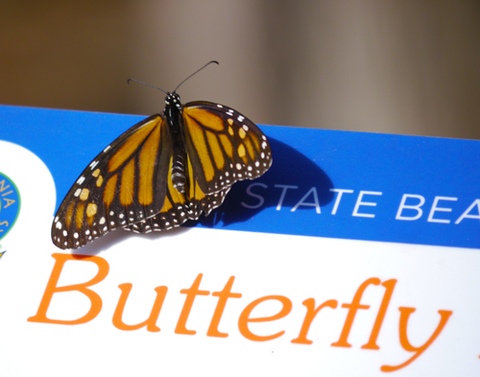
The David Suzuki Foundation is excited to be the Canadian partner in the tri-lateral Mayors' Monarch Pledge. The initiative aims to encourage mayors and other local government chief executives to take community-wide actions to help save the monarch butterfly.
Following its launch by the National Wildlife Federation in the United States in September 2015, mayors across the US took the pledge and began taking actions to help save the monarch butterfly. Within 18 months, over 300 cities had taken the Mayors' Monarch Pledge across the United States.
While the pledge was originally designed for municipalities in the United States, the pledge is being expanded in summer 2017 to Canada and Mexico through the Commission for Environmental Cooperation.
Trilateral collaboration is critical for a species like the monarch butterfly whose eastern population's (east of the continental divide) multigenerational migration spans the three countries.
Monarch butterflies "overwinter" in the oyamel fir forests of the Sierra Madre Mountains west of Mexico City. In the spring they head north, mate and lay eggs on milkweed in the northern states of Coahuila, Nuevo León, and Tamaulipas in Mexico and Texas in the United States. Four additional generations will spread north across the northern United States and southern Canada.
All three countries play a critical role in saving the monarch butterfly!
Stay tuned for more information on how to join the monarch mayor's pledge in Canada.
Hey! Want more DSF? Join David Suzuki on Facebook

David Suzuki's Blog
- David Suzuki's profile
- 247 followers



